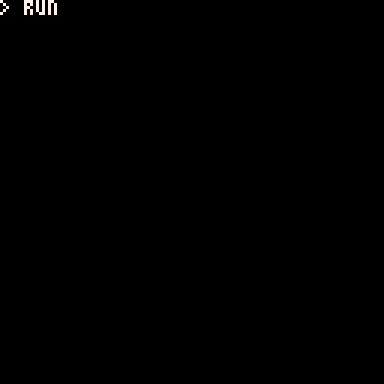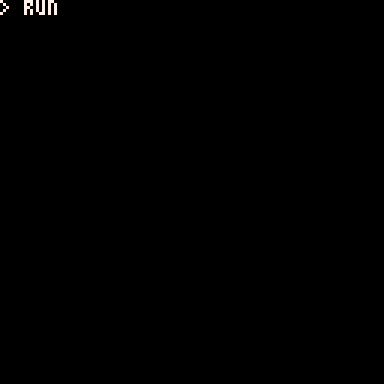PICO-8 Tweetcart Studies
Owl House Spell
Author: bean borg (@beanborg)
Link: https://twitter.com/beanborg/status/1372709786601598983

Summary
This is a cool little cart with some animation and a flame effect! cls() is never called – the cart uses this fact to draw a bunch of separate-looking candles around the outside (see the cls-vs-dithering page for some more info on this).
Because this is how it’s animated, adjusting the time (the a=t()/3) changes how close or far apart the candles are. If the time goes quicker (a=t()/2) the candles are further apart, and the time being slower means the candles are closer together, shown in the examples below.
For the flame effect, the cart uses memcpy() to very efficiently shift the whole screen up one pixel – take a look at the memory layout wiki page for some more info on how this works.
This cart also uses condensed line() calls to pack a lot of geometry into a short amount of space. Take a look at which line() functions only contain a single x,y set of parameters, and lookup ‘endpoints’ on this wiki page.
Pictures

This is how the effect looks with a cls() after each frame.

This is how the effect looks when the time is slowed down, a=t()/3 replaced with a=t()/5.
Tweet code
i=63c=circ l=line::_::flip()a=t()/3if(a>1)memcpy(24576,24640,8127)for i=0,999do c(rnd(128),rnd(128),1,0)end c(i,i,60,10)
c(i+60*sin(a),i+60*cos(a),1)c(i,i,49)c(i,39,9)l(i,111,i,49)l(54,39,i,15)l(72,39)l(60,49,18,83)l(108,83)l(66,49)l(55,77,70,70)l(55,70,70,i)goto _Breakdown
-- the default colour when running carts is grey (6),
-- and that colour's used until the draw call below
-- (that only runs after the outer circle gets
-- completed) sets it to yellow (10)
-- centre of the circle (x and y)
i=63
-- start the rendering loop
::_::
flip()
-- current time
a=t()/3
-- do this after we've drawn the whole circle! this
-- works because we draw the circle based on 'a' too.
if (a>1) then
-- shift the screen up 1 pixel
memcpy(24576,24640,8127)
-- pixely fadeout!
for i=0,999 do
circ(rnd(128),rnd(128),1,0)
end
-- outer circle! the '10' here sets the colour to
-- yellow, and that colour's used for all of the draw
-- calls in the cart from now on, too (well, the
-- pixely fadeout above sets the default colour to 0,
-- but this sets it back to 10 right after that).
circ(i,i,60,10)
end
-- draw the tiny circles.
--
-- so this is interesting! because cls() is never
-- called, this one circ() call allows us to draw all
-- of the little circles around the border. each new
-- one is a brand-new circle in a different place and
-- we just keep seeing the old, already-drawn ones.
-- then when the fire-effect happens, all the old
-- circles disappear into a puff of flames, gone with
-- the wind
circ(i+60*sin(a),i+60*cos(a),1)
-- draw the background pattern.
-- keep in mind, for the line() calls, that the cursor
-- stays where the last draw happened, and starts from
-- that point for the line calls that only contain a
-- new x and y
circ(i,i,49)
circ(i,39,9)
line(i,111,i,49)
line(54,39,i,15)
line(72,39)
line(60,49,18,83)
line(108,83)
line(66,49)
line(55,77,70,70)
line(55,70,70,i)
goto _